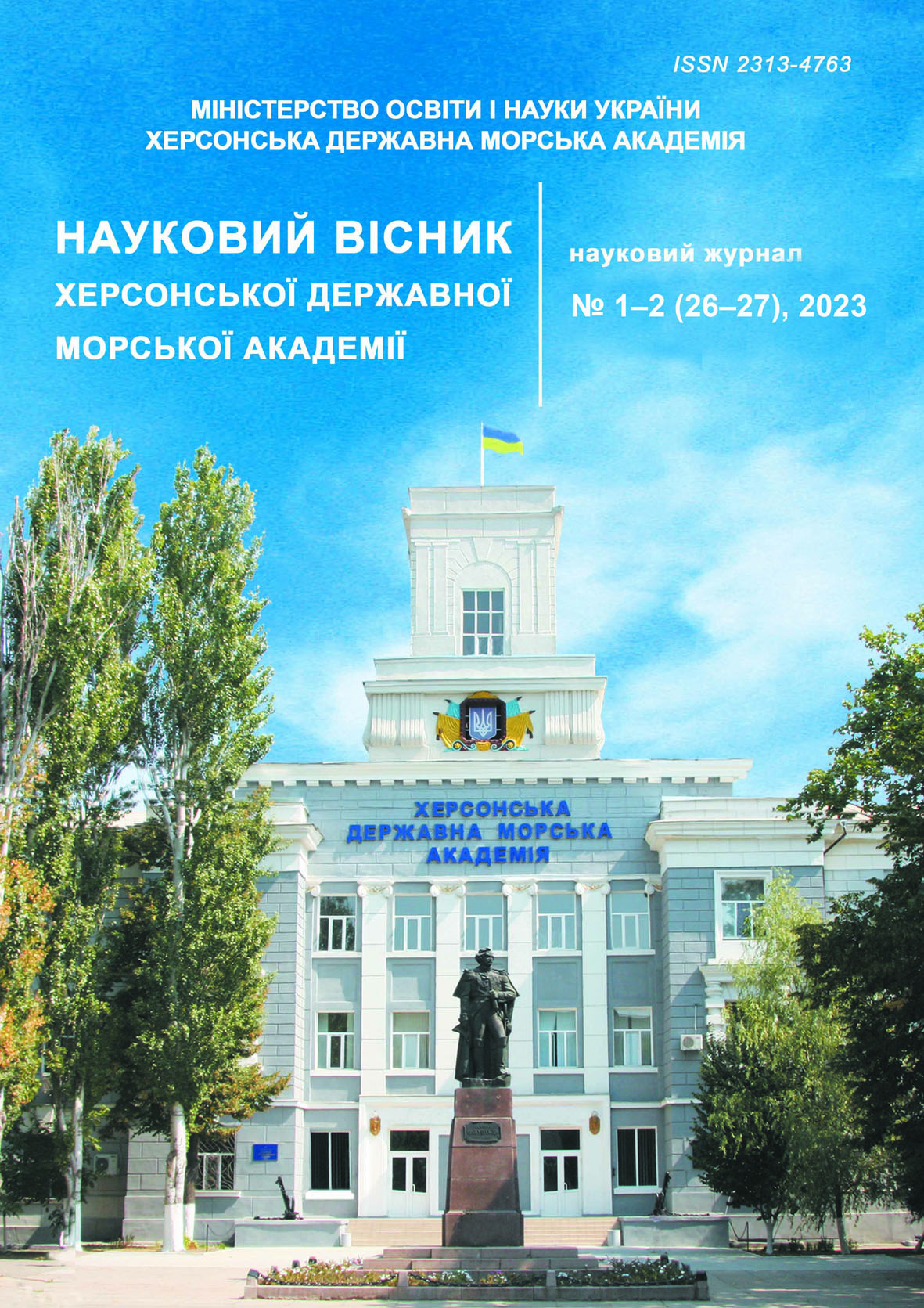ENHANCEMENT OF SHIP HANDLING TECHNIQUES ALONG A PREDETERMINED TRAJECTORY
https://doi.org/10.33815/2313-4763.2023.1-2.26-27.029-043
Abstract
The current research examines the complexities and solutions associated with the automation of maritime navigation, focusing on the improvement of automatic devices and systems for controlling the movement along a given trajectory. This paper offers a comprehensive review of contemporary mathematical models, functioning algorithms, and their implementation methodologies, assessing their impact on the effectiveness of trajectory control systems. The potential limitations of certain implementation methods and the corresponding necessity to reassess control laws or to find novel approaches for the parametric and structural identification of the ship handling process are emphasized. The purpose of the research is to refine the methods employed in trajectory-based ship control. The study presents mathematical correlations of motion along linear and curved trajectories and establishes the interconnections between the vessel’s route and the required dynamic parameters for maintaining the ship on its trajectory. The research provides a clear and concise framework that facilitates the comprehension and application of trajectory-based maritime control. The efficiency of the proposed algorithm is confirmed through the simulation of the S-175 container ship’s movement, which not only enhances the value of the research but also lays a robust groundwork for prospective investigations in this field. Looking at future prospects in the field, the researchers plan to continue work in this direction, focusing on further improvement of ship trajectory control methods and studying new approaches to parametric and structural identification of the ship control process. They also plan to conduct further simulations to test the effectiveness of their algorithm and explore its potential applications in other areas of maritime shipping.
References
Pipchenko, O. and Shevchenko, V. (2010). “K voprosu avtomatizirovannogo upravleniya sudnom na traektorii,” Shipping & Navigation, vol. 19, pp. 149–155.
Pipchenko, O. and Shevchenko, V. (2018). “Robust Automatic Ship Heading Controller For Various Conditions,” Marine Intellectual Technologies - Scientific journal, vol. 4, no. 04, pp. 208–214.
Liu, Z. (2019). “Practical backstepping control for underactuated ship path following associated with disturbances,” IET Intelligent Transport Systems, vol. 13, no. 5, pp. 834–840, doi: 10.1049/iet-its.2018.5448.
Fu, M., Shang, W., and Wang, T. (2019). “Robust Sliding Mode Control-Based Trajectory Tracking Control for an Underactuated Surface Vessel With Prescribed Performance,” 2019 Chinese Control Conference (CCC), doi: 10.23919/chicc.2019.8865240.
Zhang, G. et al. (2018). “A novel adaptive second order sliding mode path following control for a portable AUV,” Ocean Engineering, vol. 151, pp. 82–92, doi: 10.1016/j.oceaneng.2017.12.054.
Sun, Z., Zhang, G., Yi, B., and Zhang, W. (2017). “Practical proportional integral sliding mode control for underactuated surface ships in the fields of marine practice,” Ocean Engineering, vol. 142, pp. 217–223, doi: 10.1016/j.oceaneng.2017.07.010.
Sun, Z., Zhang, G., Yang, J., and Zhang, W. (2017). “Research on the sliding mode control for underactuated surface vessels via parameter estimation,” Nonlinear Dynamics, vol. 91, no. 2, pp. 1163–1175, doi: 10.1007/s11071-017-3937-8.
Zheng, Z., Huang, Y., Xie, L., and Zhu, B. (2018). “Adaptive Trajectory Tracking Control of a Fully Actuated Surface Vessel With Asymmetrically Constrained Input and Output,” IEEE Transactions on Control Systems Technology, vol. 26, no. 5, pp. 1851–1859, doi: 10.1109/ tcst.2017.2728518.
Zheng, Z. and Feroskhan, M. (2017). “Path Following of a Surface Vessel With Prescribed Performance in the Presence of Input Saturation and External Disturbances,” IEEE/ASME Transactions on Mechatronics, vol. 22, no. 6, pp. 2564–2575, doi: 10.1109/tmech.2017.2756110.
Zheng, Z. and Sun, L. (2017). “Error-constrained path-following control for a stratospheric airship with actuator saturation and disturbances,” International Journal of Systems Science, vol. 48, no. 16, pp. 3504–3521, doi: 10.1080/00207721.2017.1381889.
Zheng, Z., Sun, L., and Xie, L. (2018). “Error-Constrained LOS Path Following of a Surface Vessel With Actuator Saturation and Faults,” IEEE Transactions on Systems, Man, and Cybernetics: Systems, vol. 48, no. 10, pp. 1794–1805, doi: 10.1109/tsmc.2017.2717850.
Fossen, T. I. (2011). “Handbook of Marine Craft Hydrodynamics and Motion Control,” doi: 10.1002/9781119994138.
Ghommam, J., Ferik, S. E., and Saad, M. (2018). “Robust adaptive path-following control of underactuated marine vessel with off-track error constraint,” International Journal of Systems Science, vol. 49, no. 7, pp. 1540–1558, doi: 10.1080/00207721.2018.1460412.
Karney, C. F. F. (2012). “Algorithms for geodesics,” Journal of Geodesy, vol. 87, no. 1, pp. 43–55, doi: 10.1007/s00190-012-0578-z.
Vincenty (1975). “Direct and inverse solutions of geodesics on the ellipsoid with application of nested equations,” Survey Review, vol. 23, no. 176, pp. 88–93, doi: 10.1179/sre.1975.23.176.88.
Lukomskij, Yu. A., Peshekhonov, V. G. and Skorohodov, D. A. (2002). “Navigaciya i upravlenie dvizheniem sudov”, Uchebnik. SPb.: Elmor. 360 p.






